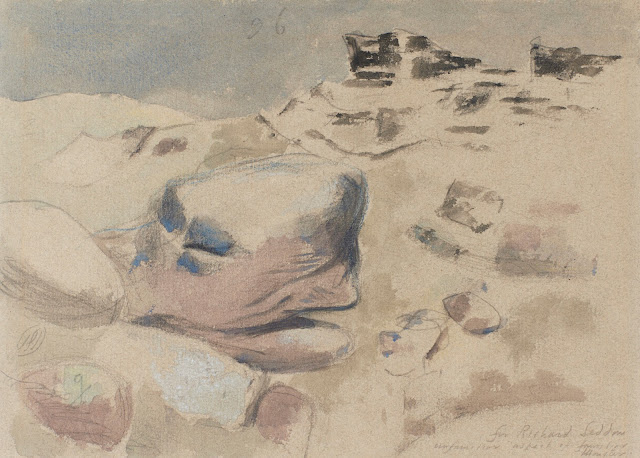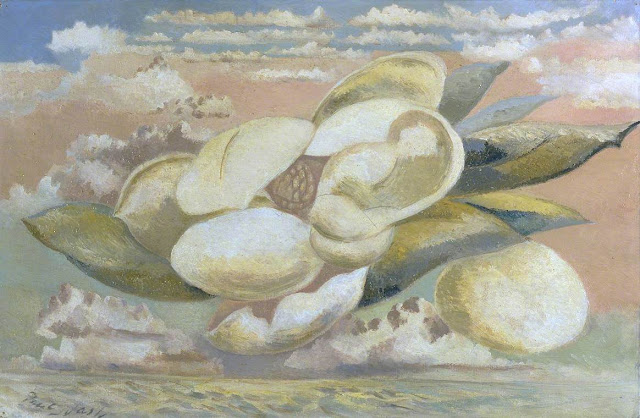 |
| Paul Nash 1935 by Helen Muspratt © The Estate of the Artist |
Paul Nash was one of the most individual British artists of his period, taking a distinguished place in the English tradition of deep attachment to the countryside whilst at the same time responding imaginatively to European modernism. He saw himself as a successor of William Blake and Turner.
After training at the Slade School he served in the First World War, was wounded, and worked as an Official War Artist, his work including some powerful views of the pitted and shattered landscape of No Man's Land that rank among the most memorable images of the conflict.
Although his later career was varied and distinguished, many critics feel that his First World War paintings mark the summit of his achievement. In the 1920s and particularly in the 1930s he was influenced by Surrealism (above all by Giorgio de Chirico, an exhibition of whose work he saw in London in 1928)
and often concentrated on mysterious aspects of the landscape.
For much of this time he lived in rural areas (Kent, Sussex, Dorset), basing his work on scenes he knew well but imaginatively transforming them. However, he continued to be involved in the London art world, and in 1933 he was the prime mover in the formation of Unit One; he also helped to organise and exhibited in the International Surrealist Exhibition in London in 1936. In the Second World War he was again an Official War Artist. He was already very sick with the asthmatic condition that killed him, but his war work included an acknowledged masterpiece, Totes Meer (Dead Sea), which portrays shot-down aircraft with their wings looking like undulating waves.
Nash was regarded as one of the finest book illustrators of his time; he also designed scenery, fabrics, and posters, and was a photographer and writer, his books including a guide to Dorset (1936). His brother John (1893–1977) was also a painter and illustrator, excelling in meticulous flower drawings for botanical publications. Like Paul he was an Official War Artist in both world wars.
This is part 6 of a 7 - part series on the works of Paul Nash:

1943 Landscape of Toad's Mouth Rock
pencil, watercolour and crayon on paper 20 x 28 cm
1943 Maiden Castle, Dorset
pencil, chalk and watercolour 29 x 39.5 cm
1943 Michaelmas Landscape
oil on canvas 63.2 x 76.2 cm
Ferens Art Gallery, Kinston upon Hull, UK
1943 Sunflower and Sun
watercolour on paper 56 x 38 cm
British Council Collection, London
c1943-44 Wittenham Clumps
pencil and oil on canvas 63.3 x 75.7 cm
Tate, London
1944 Battle of Germany
oil on canvas 121.9 x 182.8 cm
Imperial War Museums, London
1944 Dawn Flowers
pencil and watercolour 39 x 56 cm
1944 Flight of the Magnolia
oil on canvas 51.1 x 76.2 cm
Tate, London
1944 Flight of the Magnolia
pencil, pen and ink, and watercolour on paper 27.3 x 38.7 cm
Santa Barbara Museum of Art, CA
1944 Landscape of the Moon's Last Phase
oil on canvas 63.5 x 76.2 cm
Walker Art Gallery, Liverpool, UK
1944 Landscape of the Vale
watercolour 28.8 x 39.4 cm
British Museum, London
1944 Landscape of the Vernal Equinox (III)
oil on canvas 63.5 x 76.2 cm
National Galleries of Scotland, Scottish National Gallery of Modern Art, UK
1944 March Landscape
oil on canvas 69.8 x 84.8 cm
Museums Sheffield, UK
1944 March Woods, Study II
pencil and watercolour 38.1 x 55.9 cm
1944 Nocturnal Flowers
watercolour and pastel on paper 27.9 x 38.1 cm
Santa Barbara Museum of Art, CA
1944 Nocturne, Landscape of the Vale
watercolour on paper 38 x 55 cm
Rye Art Gallery, Sussex, UK
1944 Sunset Flower
pencil, watercolour and pastel 50.8 x 36.8 cm
c1944 Cumulus Head
(details not found
c1944 Cumulus Head
watercolour and crayon 34.3 x 52.8 cm
1944c Edge of the Wood
pencil and watercolour on buff paper 38.7 x 57.2 cm
Swindon Museum and Art Gallery, UK
1945 Eclipse of the Sunflower
oil on canvas 71.1 x 91.4 cm
British Council Collection, London
1945 Eclipse of the Sunflower
watercolour 41.9 x 57.2 cm
Victoria & Albert Museum, London
1945 Landscape Emerging, Study No.3
charcoal and watercolour 27.9 x 38.1 cm
1945 Solstice of the Sunflower
oil on canvas 71.3 x 91.4 cm
National Gallery of Canada, Ottawa
1945 Sunset Eye, Study 3
watercolour on paper 29 x 40 cm
c1945 Sunflower and Sun
oil on canvas 63.5 x 50.8 cm
1946 Landscape with Inhabited Sky
pencil and watercolour on card 24 x 32 cm
Private Collection
1946 The Sunflower Rises
pencil, crayon and watercolour on paper 45.2 x 59.8 cm
Scottish National Gallery of Modern Art, National Galleries of Scotland, UK
1946 Wittenham Clumps
pencil, oil and watercolour, with colour notes 55.9 x 76.2 cm
n.d. Buckinghamshire Landscape
pencil, watercolour and pastel 34 x 23.5 cm
n.d. Canterbury Bells
oil on canvas 76 x 51 cm
n.d. Douglas Goldring
pen and ink 19.6 x 15.8 cm
Dublin City Gallery, The Hugh Lane, Ireland
n.d. Dymchurch, Kent
pencil and watercolour 19.5 x 32.5 cm
n.d. Dymchurch, Kent
oil on canvas 53.5 x 75 cm
Dudley Museums Service, UK
n.d. Earth Sky
pencil and watercolour 38 x 57.5 cm
n.d. Flight of Steps in a Wood
pencil and watercolour 47 x 31 cm
n.d. Garden Steps
watercolour on paper 38.1 x 55.8 cm Private Collection
n.d. Landscape (painted verso on other work)
oil on canvas 61.2 x 50.8 cm
The Fitzwilliam Museum, Cambridge, UK
n.d. Landscape
pencil and watercolour 40 x 28.2 cm
n.d. Longdown
watercolour on paper 28 x 38 cm
n.d. Promenade
wood engraving on paper 13 x 15.5 cm
Rye Art Gallery, Sussex, UK
n.d. Sunflower
pencil, watercolour and crayon 34.3 x 24.2 cm
n.d. The Archer
oil on canvas 71 x 91.5 cm
Southampton City Art Gallery, UK
n.d. The Window, Riviera
pencil and watercolour 45 x 28.5 cm
n.d. Wittenham Clumps
pencil and watercolour 28 x 38 cm
n.d. (WWI 1914-18) Wounded, Passchendaele
oil on canvas 45.9 x 50.7 cm
Manchester Art Gallery, UK
No comments:
Post a Comment
Note: only a member of this blog may post a comment.